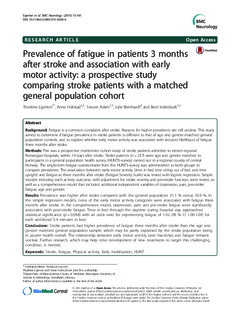| dc.description.abstract | Background
Fatigue is a common complaint after stroke. Reasons for higher prevalence are still unclear. This study aimed to determine if fatigue prevalence in stroke patients is different to that of age and gender matched general population controls, and to explore whether early motor activity was associated with reduced likelihood of fatigue three months after stroke.
Methods
This was a prospective multicenter cohort study of stroke patients admitted to eleven regional Norwegian hospitals, within 14 days after stroke. Stroke patients (n = 257) were age and gender matched to participants in a general population health survey (HUNT3-survey) carried out in a regional county of central Norway. The single-item fatigue questionnaire from the HUNT3-survey was administered to both groups to compare prevalence. The association between early motor activity (time in bed, time sitting out of bed, and time upright) and fatigue at three months after stroke (Fatigue Severity Scale) was tested with logistic regression. Simple models including each activity outcome, with adjustment for stroke severity and pre-stroke function, were tested, as well as a comprehensive model that included additional independent variables of depression, pain, pre-stroke fatigue, age and gender.
Results
Prevalence was higher after stroke compared with the general population: 31.1 % versus 10.9 %. In the simple regression models, none of the early motor activity categories were associated with fatigue three months after stroke. In the comprehensive model, depression, pain and pre-stroke fatigue were significantly associated with post-stroke fatigue. Time in bed through the daytime during hospital stay approached statistical significance (p = 0.058) with an odds ratio for experiencing fatigue of 1.02 (95 % CI 1.00-1.04) for each additional 5.4 minutes in bed.
Conclusions
Stroke patients had higher prevalence of fatigue three months after stroke than the age and gender matched general population sample, which may be partly explained by the stroke population being in poorer health overall. The relationship between early motor activity (and inactivity) and fatigue remains unclear. Further research, which may help drive development of new treatments to target this challenging condition, is needed. | nb_NO |

